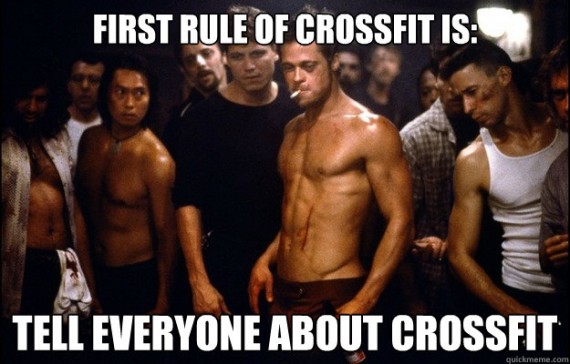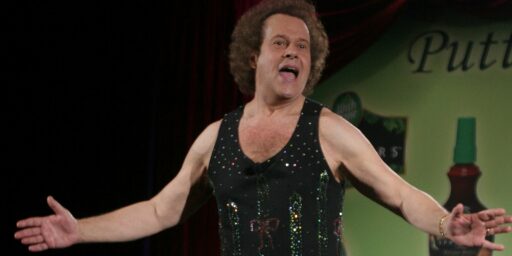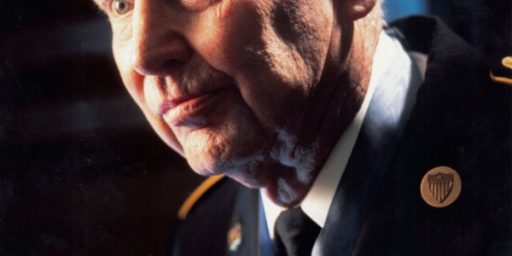Extreme Fitness Obsession
Heather Havrilesky asks, "Why Are Americans So Fascinated With Extreme Fitness?
Heather Havrilesky asks, “Why Are Americans So Fascinated With Extreme Fitness?” She actually provides zero macro-level evidence that they are and, indeed, a trip to the local mall would provide a pretty strong indicator that they’re not. Regardless, there’s no doubt that there’s a niche industry out there that’s generated some enthusiasm.
Fitness culture couldn’t have changed more significantly since the late ’60s. Back then, residents of my small Southern hometown would spot my father, an early jogger, and yell out of their car windows, “Keep running, hippie!” These days there aren’t that many joggers in my Los Angeles neighborhood, but every other block there’s another fitness center offering boot-camp classes or Brazilian jiujitsu, with people inside punching, kicking and yelling at one another like drill sergeants. Jim Fixx’s freewheeling running disciples have been replaced by packs of would-be Navy SEALs, sprinting up sandy hillsides with backpacks full of rocks strapped to their shoulders.
Jane Fonda and Richard Simmons once painted exercise as something fun and faintly sexy — a lighthearted trip to a sweaty nightclub in your own living room — but fitness today isn’t supposed to be easy. The “Abdomenizer” and “8-Minute Abs” videos, which practically suggested that exercise could be squeezed in between bites of your hamburger, are now quaint punch lines. By the ’90s, when the soft curves of Ursula Andress had been replaced by the hard bodies of Cindy Crawford and Elle Macpherson, you still worked out to prepare for the beach or the bedroom. These days, though, you aren’t preparing for fun or romance. You’re preparing for an unforeseen natural disaster, or a burning building, or Armageddon.
We have sought to build a program that will best prepare trainees for any physical contingency — not only for the unknown, but for the unknowable.” This dark talk passes for welcoming language on the website of CrossFit, the intense, ultracompetitive conditioning program whose motto, “Forging Elite Fitness,” reflects our current fascination with both elite athletes and elite military forces. In spite of (or because of) the fact that CrossFit is now nearly synonymous with overexertion, there are more than 6,000 affiliates in the United States.
Again, I’m not sure 6000 affiliates, most of which are doubtless niche operations, in a continental sized country with 310 million people is evidence of a craze. Still, even in my own circles—which, granted, are a bit skewed since I teach at a Marine Corps institution—there are quite a few devotees of CrossFit, PX90, and other “extreme” or “boot camp” style programs.
Joshua Foust thinks nihilism is at least part of the answer. And maybe so. But I think the explanation is more simple: the cultural ideals for both sexes have become radically more unrealistic while the population has gotten ever more sedentary and out-of-shape.
Now, I don’t recall Richard Simmons ever being considered sexy. As I recall, his origin story was as a former fatty who got himself in shape and wanted to inspire others to do the same. His appeal was enthusiasm and kitsch, not sexiness. He wasn’t trying to form an army of lean, mean fighting machines but to rid the world of disgusting fatbodies. Mostly to make them feel better about themselves.
Not too long after Simmons became a household name, though, the male ideal changed significantly, seemingly overnight. Simmons never represented it, of course, but the difference between Paul Newman, John Wayne, and Burt Reynolds on the one hand and Arnold Schwarzenegger, Sylvester Stallone, and Jean-Claude Van Damme on the other is palpable. Even actors playing non-action roles were suddenly decidedly more muscular and lean than their counterparts from decades past. And the older cohort were mostly star athletes in their own right.
While I think the Ursula Andress to Cindy Crawford and Elle Macpherson example a poor one—the Andress who came to fame in that bikini in the first James Bond flick had a body every bit as fit as Crawford and Macpherson in their heydays—it’s true that the female ideal has changed as well. Extreme muscle is still a niche appeal but women now are supposed to look like they spend hours at the gym.
Given a more sedentary, less fit population, that’s a problem in its own right. Additionally, for males, especially, there’s a not-so-subtle pressure that we’re not really manly unless we’re Navy SEALs, MMA fighters, or football players. As we’ve more and more moved into jobs sitting on our butts behind a computer—often with a woman in the next cubicle doing the same job—there’s a sense that we’ve lost some essential manly quality. So, for men at least, the quasi-military or quasi-two-a-days mentality of the extreme workout programs offer a way of regaining that. It’s essentially the “Fight Club” fantasy without the bruises.






It’s simple, the zombies always catch the fatties first.
Because sex sells?
Men find fit women to be sexy and … vice versa.
@al-Ameda: But that’s always been the case and we didn’t have these programs. The definition of “fit” has changed rather markedly.
I give the popularity of these extreme exercise regimes about 10 years as people drop out due to the fact that the human body can sustain only so much abuse before it starts to rebel and or breakdown. After almost 30 years of daily abuse in construction, I can assure you, the body has a limit. At the 10 yr mark I told myself I had to find a better way. I didn’t. I pay the price every waking minute of every day… And night.
Pain is not good. It is the bodies way of saying, “STOP!!!! You idiot!”
http://d24w6bsrhbeh9d.cloudfront.net/photo/5595371_700b.jpg
There is a huge market for cook books and cooking TV shows in the United States, but most Ameicans don´t cook. I think that the same happens with physical activity.
@Andre Kenji: Heh. Too true, too true.
@Andre Kenji:
“There is a huge market for cook books and cooking TV shows in the United States, but most Ameicans don´t cook.”
But they don’t need a large percentage of the public to watch/read them to be considered a huge market. If 1% of the country watches a cooking show, that’s an audience of 3 million. Same with the number attracted to extreme fitness. And 3 million viewers is a number most specialty cable shows would kill for.
Actually, if you take that trip to a local mall and compare your observations with a similar public space in Europe, you really will see that America has more extreme cases at both ends. Sure there are lots more obese people in an American mall, but you see way more gym-toned bodies as well. The Italians are stereotypically very image-conscious and yet, while you won’t find a bunch of fatties walking the streets of Milan, you won’t see guys whose biceps fill their shirtsleeves either.
As a gym-going American myself, I find that when traveling in Europe, it’s really hard to find a gym to go to on a visitor pass, whereas in the US I find that if I really want to, I can go to a different gym every day while visiting another city on business because they’re everywhere.
It’s not an obsession. It’s a fad like any other fad. More to the point, it’s a fad identified by a freelance writer using it to score a gig, so it’s got to be inflated to a national obsession.
It’s less of a permanent change in American culture than the cronut.
@Alex:
Or, as I’ve observed, when in Europe as compared to the US you won’t see that many people jogging or running. You will, however, see A LOT more people strolling and walking.
There have been obsessions before. Just think about these: 50 mile hike of the ’60’s, jogging in the ”80’s, marathons, then the walking emphasis, the tv – video craze with Fonda and Simmons. In the ’90’s upscale gyms replaced the grimy, sweaty inner city gyms of boxers. Think about the impact of movies like “Rocky” and lately “300”. The “300” workout seemed to kick off the extreme craze.
But isn’t it a throwback to the gym classes we had long ago ? The pe teacher had every physical torture that they could think of: running up the bleachers, rope climbing, piggy back squats, wind sprints, 50 yard wheel barrow races, 100 jumping jacks. Now some of you can describe your favorites.
I guess people want some excitement in their life.
@James Joyner:
Actually I think its drifted downward, at least in practice. A couple hundred of years ago your average farmer could push a plow behind a team of oxen or draft horses for consecutive twelve hour days until they were in their fifties (if you ever get a chance, try this – its brutal). Most of the Hollywood fit types mentioned would collapse after the first couple hours. Same for most gym rats. Anyone who coaches (wrestling and judo for me, but I’ve heard this from coaches in a lot of sports) will tell you the same thing – the gym rat/fitness model look seems to produce decidedly inferior athletes.
Pro-athletes tend to look fit in the old fashioned way, rather than the modern buff look you’re talking about. That’s because they actually have to be fit for their jobs. Fitness models and actors can afford to concentrate on cosmetic fitness, because they never actually have to perform.
@Moosebreath: I don´t see many cooking shows in Brazilian TV. 🙂
@george: Talk about pushing plows, take a look at the training and strength program at the University of Florida basketball program. You have men out side pulling trucks with ropes and pushing a truck up hill.
See University of Florida basketball – extreme training.